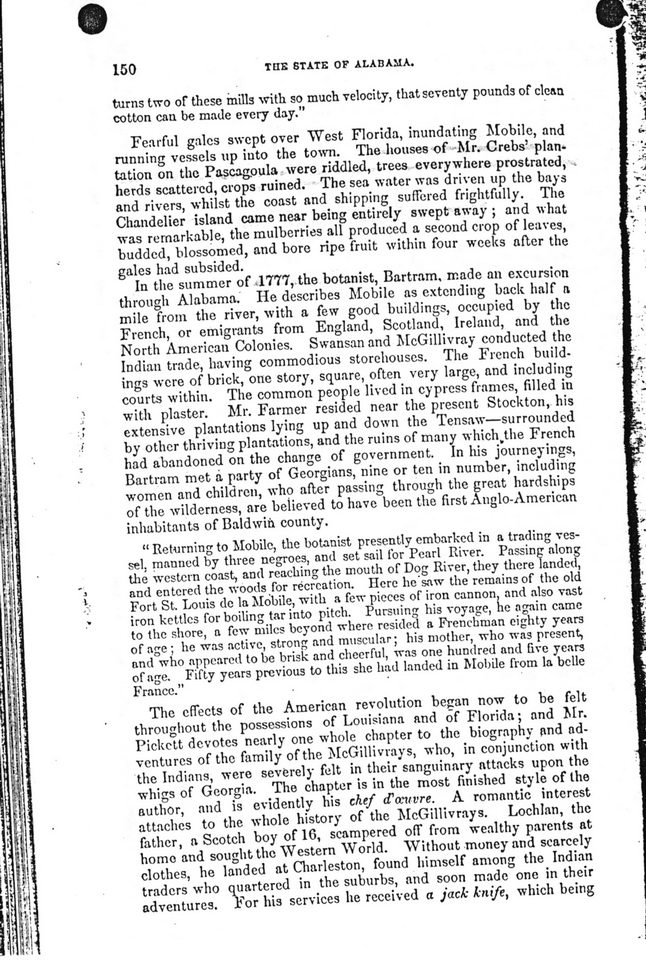This text was obtained via automated optical character recognition.
It has not been edited and may therefore contain several errors.
150 THE STATE OF ALABAMA. turns two of these mills with so much velocity, that seventy pounds of clcan cotton can be made every day.? Fearful gales swept over West Florida, inundating Mobile, and running vessels up into the town. The houses of-Mr. Crebs? plantation on the Pascagoulaswere riddled, trees everywhere prostrated, herds scattered, crops ruined. The sea water was driven up the bays and rivers, whilst the coast and shipping suffered frightfully. The Chandelier island came near being entirely swept away ; and what was remarkable, the mulberries all produced a second crop of leaves, budded, blossomed, and bore ripe fruit within four weeks after the gales had subsided. In the summer of .1777, the botanist, Bartram, made an excursion through Alabama. He describes Mobile as extending back half a mile from the river, with a few good buildings, occupied by the French, or emigrants from England, Scotland, Ireland, and the North American Colonies. Swansanand McGillivray conducted the Indian trade, having commodious storehouses. The French buildings were of brick, one story, square, often very large, and including courts within. The common people lived in cypress frames, filled in with plaster. Mr. Farmer resided near the present Stockton, his extensive plantations lying up and down the Tensaw?surrounded by other thriving plantations, and the ruins of many which^the French had abandoned on the change of government. In his journeyings, Bartram met a party of Georgians, nine or ten in number, including women and children, who after passing through the great hardships of the wilderness, are believed to have been the first Anglo-American inhabitants of Baldwin county. ? Returning to Mobile, the botanist presently embarked in a trading vessel, manned by three negroes, and set sail for Pearl River. Passing along the western coast, and reaching the mouth of Dog River, they there landed, and entered the woods for recreation. Here he saw the remains of the old Fort St. Louis de la Mobile, with a few pieces of iron cannon, and also vast iron kettles for boiling tar into pitch. Pursuing his voyage, he again came to the shore, a few miles beyond where resided a Frenchman eighty years of age; he was active, strong and muscular; his mother, who was present, and who appeared to be brisk and cheerful, was one hundred and live years of age. Fifty years previous to this she had landed in Mobile from la belle France.? The cffects of the American revolution began now to be felt throughout the possessions of Louisiana and of Florida; and Mr. Pickctt devotes nearly one whole chapter to the biography find adventures of the family of the McGillivrays, who, in conjunction with the Indians, were severely felt in their sanguinary attacks upon the whi^s of Georgia. The chapter is in the most finished style of the author, and is evidently his chef d'anivre. A romantic interest attaches to the whole history of the McGillivrays. Lochlan, the father, a Scotch boy of 16, scampered off from wealthy parents at homo and sought the Western World. Without money and scarcely clothes, he landed at Charleston, found himself among the Indian traders who quartered in the suburbs, and soon made one in their adventures. For his services he received a jack knife, which being

Alabama Debows-Review-Feb1852-V12-4